Using Information in Human Resources
The below is a module 6 submission for the CIPD Level 5 certification, kindly shared by one of our clients to help you on your own HR journey. Next is, Using Information in Human Resources.
Contents
Part One – Understand the research process and different research approaches
1.1 Summarise the stages of the research process and compare different data collection methods
Part Two – Be able to conduct a critical review of information sources in an area of HR/ business practice and analyse the findings
2.1 Identify an area of HR practice for investigation
2.2 Conduct a critical review of different information sources relevant to the chosen area of HR/business practice
Part Three – Be able to draw meaningful conclusions and evaluate options for change
3.1 Draw meaningful conclusions from the review and make justified recommendations for improvements in practice
7 Other Submissions
Check out the other 7 module submissions here:
- Module #1 Improving Organisational Performance
- Module #2 Contemporary Developments in Employment Relations
- Module #3 Employment Law
- Module #4 Developing Professional Practice
- Module #5 Business Issues and The Contexts of Human Resources
- Module #7 Employee Engagement
- Module #8 Managing and Co-ordinating the Human Resources Function
Part One – Understand the research process and different research approaches
1.1 Summarise the stages of the research process and compare different data collection methods
There are various stages of the research process as stated by Anderson 2013 and listed by MOL (Using Information in Human Resources, 2020)

As you can see by the diagram above, there are logical stages you should take when you are thinking about researching a process, procedure or product. The define stage, is simply to establish what you wish to research and this could be done by mind mapping with colleagues, looking at issues already highlighted by errors made or because there is specific interest to the person or company. You need to have a clear scope and specific outcome/s or objectives to ensure you stay on track and remain focused on the end goal; I believe if you write it down you are more likely to succeed in achieving it. The second stage is to establish what you already know; why has the area of choice been chosen? What are the reasons, issues and factors behind it? Will there be any ethical or political conflicts you need to consider? Has any research been done before? The third stage is to gather your primary and secondary data.
Primary research is a new data capturing exercise that looks at information and sources you already have access to in the business; it could be such things like, sending employee engagement surveys (depending on the focus area) or looking at information already held in systems used such as absence and sickness reports. You could hold round table events with open discussions or run polls but all types of data will be different in one way or another.
If you compare an engagement survey to a sickness and absence report, the engagement survey is based upon people’s opinions, theories and what they deem or know to be true, whereas a sickness and absence report is based on factual data that is input by someone. This can help with forecasting once the historic information has been reviewed, measured, compared and analysed.
Surveys will not necessarily add a depth of understanding or provide hard core evidence as they tend to be questions requiring a short answer (unless the questions are very specific and succinct answers are given) whereas a sickness and absence report, can give you factual reasons that are supported by return to work interviews, doctors notes, stage interview notes or letters etc. No matter what the data is, if it is held on file, it can be used to look at trends in the required area.
Secondary research is existing data looking at external sources such as surveys already run i.e. salary benchmarking, gender pay gap etc. Another example is looking at various websites such as CIPD, government, Deloitte, KPMG and many more as well as researching journal articles and credible blogs. Both primary and secondary data will include qualitative and quantitative for example; a round table event from primary research would be classed as qualitative because it is descriptive but a report from the HR system that gives numbers would be quantitative because you can measure the figures.
The fourth stage is to drill down into the research and analyse it; how credible is it? How much weight does it hold in the industry? Some internet data can be conflicting (Taylor and Woodhams, n.d.) and it should be looked at with a critical eye as well as questions being asked around it; it could be too commercial or biased. Depending on the data provided would depend on the way you analyse it. If you have qualitative data from either primary or secondary, you would possibly read what you have, make notes and comparisons with the outcome or objective in mind and come to your conclusion thereafter. Below are a few more examples taken from (Abdulkareem, 2018)
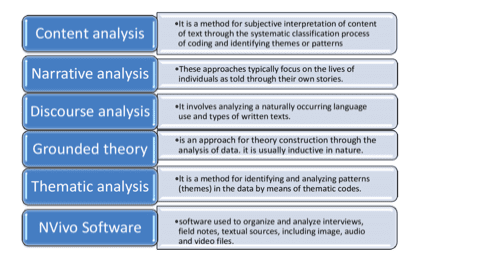
I think quantitative data is much easier to measure as it is factual and unless the data is flawed (which you would have already established) it provides black-and-white evidence that can form a decision; some examples of tools are Excel, Access and other bespoke systems as shown in the diagrams below:
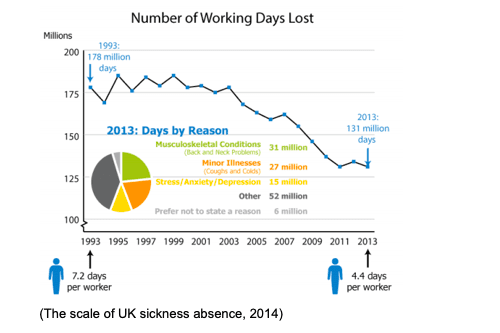
The scale of UK sickness absence, 2014)
Qualitative information draws out patterns from concepts and insights whereas quantitative tests hypotheses use data to support conclusions (Nigatu Haregu, 2012). Both are valuable if used in the correct way.
Part Two – Be able to conduct a critical review of information sources in an area of HR/ business practice and analyse the findings
2.1 Identify an area of HR practice for investigation
I have chosen Mental Health in the workplace and the need for managers to receive mandatory training as an area of investigation. I have chosen this area as I am a qualified Mental Health First Aid Instructor and when I joined the company it was very apparent that line managers were unaware or ignorant to their staff’s emotional needs. They were not aware of the benefits around how acquiring some basic knowledge in a few areas, could help reduce stigma around mental health and make a huge difference in the day-to-day life of their employee as well as improving the work and morale.
When I joined, I trained 22 employees across London and Newcastle to become mental health first aiders, ensuring the people on the course actually wanted to be there and understood the importance of it. There was a mixture of employees and managers of all levels and even two directors attended. Once the training was complete, everyone was talking about it and the senior managers, who attended, started to implement and use the skills they had learnt.
They became much more aware and empathetic to their staff’s needs. Instead of ignoring issues, they would ask direct, but not intrusive questions to ascertain the problem and be confident in opening up a conversation. This allowed them to help the person find a way forward that could achieve a positive outcome and therefore meant they were happier at work and did not need to take time off sick for stress, depression or anxiety for example.
After speaking to the Head of Organisational Development about my suggestion, she was fully on board. I explained my findings and rationale for wanting to extend the training to managers and make it mandatory. I explained there are many sources of information that suggest having mental health first aiders or employees that are aware of mental health, may reduce the amount of time employees take off sick, reduce presenteeism, reduce the expenditure around absence due to mental health and increase employee engagement.
I highlighted statistics provided by the Mental Health Foundation (Mental health statistics: mental health at work, n.d.) along with Mental Health First Aid England (Adult two day statistic crib sheet, 2020) as below.
Mental Health Foundation
- 1 in 6.8 people experience mental health issues within the workplace
- “Evidence suggests that 12.7% of all sickness absence days in the UK can be attributed to mental health conditions”
- When employees have healthier mental health, it could save UK businesses up to 8 billion each year
- “Promoting wellbeing at work through personalised information and advice, a risk-assessment questionnaire, seminars, workshops and webbased materials will cost approximately £80 per employee per year. For a company with 500 employees, where all employees undergo the intervention, it is estimated that an initial investment of £40,000 will result in a net return of £347,722 in savings, mainly due to reduced presenteeism (lost productivity that occurs due to an employee working while ill) and absenteeism (missing work due to ill health)”
- Due to the size of our organisation (450), this figure is extremely relevant
Mental Health First Aid England:
- “1 in 4 people experience mental health issues each year”
- “At any given time, 1 in 6 working-age adults have symptoms associated with mental ill health”
From the little evidence, I have provided, and by the research I highlight below, you should see that by ensuring all managers receive mandatory mental health training, it could only have a positive effect on the business. Managers will be armed with the knowledge and confidence to read the signs, have difficult conversations and therefore make the workplace an enjoyable place for everyone.
2.2 Conduct a critical review of different information sources relevant to the chosen area of HR/business practice
Priory Group
Mental Health in the workplace is quite often a sensitive subject and still has stigma surrounding it, which is why I believe training should be mandatory for managers. The Priory Group have stated that 71% of the people they have spoken to, would worry about speaking to their manager/employer about any mental health condition they may have or have had. The figures below break the levels of worry down by age group (Mental health stigma silences employees | Priory Group, n.d.) For me, these figures show too higher level of worry surrounding mental health in the workplace.
If we base the figures on 100 people, per age group, in one organisation (400) and could reduce each level of worry by 15% that could reduce the personal impact on employees by 41.55 (headcount).
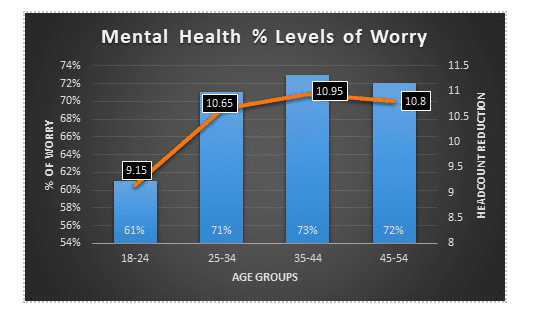
The priory group are predominantly known for their mental health services for the rich and famous, so you could argue that this would give the impression that they are not credible and are just a money-making machine. However, as well as having experts in poor mental health, they also deliver a range of other services. Although the priory group studies may appear biased and have a vested interest, they do pull on resources and work with other credible mental health providers such as charities like Mind and Rethink Mental Illness which have been established and cited since 1946 and 1972.
Deloitte
Another source that highlights the impact of addressing mental health in the workplace but is contrary to the above, is the Deloitte study carried out in 2017 (Mental health and employers: the case for investment, 2017) where they aim to support the findings of the commissioned report by Stevenson and Farmer.
Deloitte suggests that instead of providing reactive support to employees with a mental health illness, employers should apply proactive support as well as introduce “preventative stages”. They should also look to deliver a better “average return on investment”.
The below diagram shows an employee’s journey detailing what employers could do to help them and what could happen if the employee is overlooked or misunderstood.
You can see the transition, and how a state of ill health can change (as highlighted by point 1 to 11). In addition, depending on how an organisation deals with mental health, will depend on the outcome for the employee (emotionally and potentially physically) and the employer (financially or the credibility of the company). What Deloitte does not mention in the journey, is how they identified each stage. What constitutes an employee to be in “good health”, what structure should be put in place for the journey of an employee to be followed and managed appropriately? Is there a right or wrong way to help? (Some businesses simply do not have the knowledge and would need more guidance)
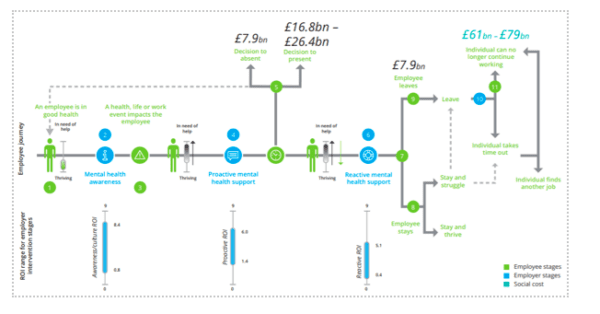
They go on to say that according to the CIPD, the Private and Public sectors are very different with the Public sector showing a loss of 3 days per person, per year whilst the Private sector is 1 day per person, per year as well as presenteeism being more prevalent in the Public sector.
The aim of Deloitte’s report was to report three things, the cost of mental health to employers, and the return on investment to employers by introducing mental health initiatives and what could be learnt. They report an average ROI to be a 4.2:1.By collating information from various data sources provided by credible organisations, and other countries, they have established that having a well-rounded mental health focus is beneficial and by ensuring key stakeholders are involved, it will aid in the success. Depending on the country as they may have already introduced legislation to protect the mental health and wellbeing of employees such as Sweden, Belgium and France.
ProQuest
ProQuest published an article written by Nic Paton and Personnel Today about how mental health at work was affecting employees and businesses alike. Nic Paton is an award-winning freelance journalist who writes about many topics such as employment and health and education etc. (Poor mental health reduces workplace productivity levels – ProQuest, 2009)
The article draws on reviews by the CIPD and NICE (National Institute for Health and Care Excellence). The CIPD suggest the same as the above findings, that when they have looked at surveys more than one-quarter say that their mental health is not good and that it affects their working lives. Just like Deloitte, it suggests that even though employees have a mental health illness or low mental health, they still attend work due to the stigma attached. This of course increases presenteeism and means the business will lose money, as the employee is less productive.
A quote from the article made by Ben Wilmott who was a senior public policy adviser at the time, sums up what I’m trying to achieve. He said, “The starting point for addressing poor mental health at work is good people management by front-line managers and supervisors” He then mentioned the guidance NICE had published suggesting that organisations could save £250,000 per year if they implemented his suggestion.
At the request of the World Health Organisation, NICE was tasked to “develop public health intervention guidance aimed at promoting employees’ mental health.” They carried out several workshops and telephone interviews, which led them to provide an eight-stage recommendation structure. (Evidence | Mental wellbeing at work | Guidance | NICE, 2009)
They estimated a loss of £353 – £381 million to organisations and between £3.7- £3.8 billion cost to society. These figures are much lower than what Deloitte suggest but their report was carried out in 2017 and the NICE one, in 2009; does this suggest the problem is getting worse or that more employees are talking about their mental health issues and therefore highlighting a bigger issue than what was first thought?
Aioi Nissay Dowa
I believe, because there have been various studies like the above and more awareness has been raised; we are more likely to be honest about mental health in the workplace. Since introducing Mental Health First Aiders into our organisation, we have seen a change in sickness absence trends with a slight increase from the more common absence reasons like muscle skeletal, colds, headaches and infections when compared to mental health illness as seen in the below and with the exception of the last three months in the year.
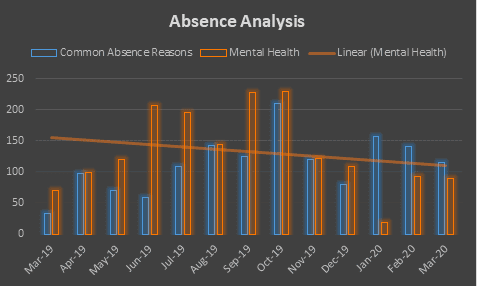
Part Three – Be able to draw meaningful conclusions and evaluate options for change
3.1 Draw meaningful conclusions from the review and make justified recommendations for improvements in practice
Although mental health is a sensitive subject it is very important for it not to be overlooked especially in the workplace. Each source of information has provided evidence and suggestions that I believe support my case to implement mandatory mental health awareness training for all managers. The level of worry and impact the Priory highlighted was very relevant to our business size and if we can reduce that level, by equipping our managers with the correct level of knowledge to pick up on warning signs mental health may present then we could also reduce a level of presenteeism we most certainly have. If 71% of our employees were worried about speaking to their manager about any mental health-related illness, that could mean, with a base of our sitting at 450 employees, 319.5 of them would potentially not feel comfortable which could lead to an increase in sickness or attrition of valued staff because they felt they aren’t supported.
Deloitte supported the findings by highlighting the positive impact early intervention can have on an organisation’s finance and investment. Although they reported a return on investment of 4.2:1, NICE suggest that businesses can save a massive £250,000 per year if employees are invested in, and feel supported around their mental health.
I have shown the impact mental health first aid training can have on our business by training 22 employees and ensuring they are recognised and easily accessible to everyone in our company. We can see a reduction in sickness days lost and see that people are becoming more confident at discussing the real reason they may need to take some time out of work. We can use this information to gain a deeper understanding of how we can help employees cope with everyday working life and reduce sickness levels.
From the research, I have carried out and the data sources I have used, I believe it provides the evidence needed for mandatory mental health awareness training to be implemented for all managers. The evidence above clearly shows that when employees are invested in, feel listened to and understood, they are more productive and less likely to take time out of work for mental health illnesses, unless they are severe of course.
My recommendations are as follows:
- Compile a list all managers at all levels
- Run an open table event to explain the relevance of mental health training
- This will help them engage with the training and make them more likely to take it seriously
- Link the training into our PACE toolkit that already exists and includes essential learning for people managers to support around policies and processes
- Implement a timeline for the delivery of the course
Costings:
As I am qualified to train in the Mental Health Awareness course as well as the two-day and one-day course, the outlay would be a fraction of the cost:
- Adult Mental Health Aware Half-Day Course manual @ £6.50 per person
- Adult Mental Health Aware Half-Day Workbook @ £6.50 per person
- Lunch @ £5.00 per person
- Travel to Newcastle including hotel stay @ £250
We have 80 managers across London, Newcastle and Epsom giving a total cost for the above of £1,730. However, as I would implement the training you would save £12,000 as each delegate would normally cost £150 for outsourced training providers.
If you take into account the reduction of presenteeism this training could eliminate, the employees would be more productive and the company would gain not just financially but also our reputation would grow and we would present ourselves as not only market leaders but also a company that genuinely cares about our employees. If we as a company look after our employees at all levels, we will flourish and be even more successful and fully implement our cultural beliefs as a business.
Bibliography of Information in Human Resources
- 2020. Using Information In Human Resources.
- Taylor, S. and Woodhams, C., n.d. Studying Human Resource Management. 2nd ed. London: The Chartered Institute of Personnel and Development, p.95.
- Nigatu Haregu, T., 2012. Qualitative Data Analysis. [online] Slideshare.net. Available at: <https://www.slideshare.net/tilahunigatu/qualitative-data-analysis-11895136> [Accessed 19 April 2020].
- Abdulkareem, A., 2018. Figure 3: Methods Of Qualitative Data Analysis.. [online] ResearchGate. Available at: <https://www.researchgate.net/figure/Methods-of-qualitative-data-analysis_fig2_329957911> [Accessed 19 April 2020].
- Full Fact. 2014. The Scale Of UK Sickness Absence. [online] Available at: <https://fullfact.org/economy/scale-uk-sickness-absence/> [Accessed 19 April 2020].
- Mhfastorage.blob.core.windows.net. 2020. Adult Two Day Statistic Crib Sheet. [online] Available at: <https://mhfastorage.blob.core.windows.net/mhfastoragecontainer/3bfa88c27ca7e8118149e0071b668081/Adult%20Two%20Day%20statistics%20crib%20sheet%20January%202020.pdf?sv=2015-07-08&sr=b&sig=xmLq6Ogd%2B5iqbfyxzN5q2uvfEJZ4DTPp6WY0pYphTyA%3D&se=2020-04-19T16%3A13%3A27Z&sp=r> [Accessed 19 April 2020].
- Mental Health Foundation. n.d. Mental Health Statistics: Mental Health At Work. [online] Available at: <https://www.mentalhealth.org.uk/statistics/mental-health-statistics-mental-health-work> [Accessed 19 April 2020].
- Priorygroup.com. n.d. Mental Health Stigma Silences Employees | Priory Group. [online] Available at: <https://www.priorygroup.com/blog/mental-health-stigma-silences-employees> [Accessed 26 April 2020].
- www2.deloitte.com. 2017. Mental Health And Employers: The Casr For Investment. [online] Available at: <https://www2.deloitte.com/content/dam/Deloitte/uk/Documents/public-sector/deloitte-uk-mental-health-employers-monitor-deloitte-oct-2017.pdf> [Accessed 26 April 2020].
- Search.proquest.com. 2009. Poor Mental Health Reduces Workplace Productivity Levels – Proquest. [online] Available at: <https://search.proquest.com/openview/6f9dd00e0e56d61a0bbe29bba804eea2/1?pq-origsite=gscholar&cbl=49149> [Accessed 27 April 2020]. Nice.org.uk. 2009. Evidence | Mental Wellbeing At Work | Guidance | NICE. [online] Available at: <https://www.nice.org.uk/guidance/ph22/evidence> [Accessed 27 April 2020].




